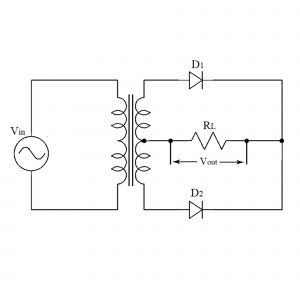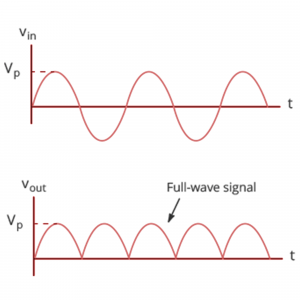How does a Full Wave Rectifier Work? An In-Depth Guide
Electric circuits that convert alternating current to direct current are known as rectifiers. There are two types of rectifiers, they are half-wave rectifiers and full-wave rectifiers. A half-wave rectifier loses a significant amount of power and is thus unsuitable for applications that require a smooth and continuous supply. We employ full-wave rectifiers for a smoother and more consistent supply. Let us know more about full wave rectifiers, in this article, along with a full wave rectifier diagram.
What is a Full Wave Rectifier?
While we have understood the basic function of a rectifier, we also know that the rectifiers come in two kinds – half-wave and full-wave rectifiers.
A Full Wave Rectifier is a rectifier that transforms both halves of each alternating wave cycle (Alternating Current) into a pulsing DC (Direct Current) signal.
Full-wave rectifiers are used for a smoother and more consistent supply of power. Full-wave rectifiers are used to convert a whole cycle of alternating current voltage (AC) to direct current voltage (DC).
Please check the full-wave rectifier diagram for a clearer understanding through the illustration
Further categorization of full-wave rectifier
Full-wave rectifier comes in two types:
- Centre-tapped full-wave rectifier
- Full-wave bridge rectifier
The differentiation between these two types of full-wave rectifiers goes a long way in understanding effectively the full-wave rectifier working
In a center-tapped full-wave rectifier, the system is made up of a center-tapped transformer, two diodes, and a resistive load. Whereas, under Full Wave Bridge Rectifier, the architecture features four diodes or more, and the resistive load. The diodes are named A, B, C, and D, and form a bridge circuit.
Full-wave rectifier Diagram
There are two ways in which a full-wave rectifier circuit can be built. The first technique involves a transformer with a central tap and two diodes. This design is known as a center-tapped full-wave rectifier. Check the full wave rectifier circuit diagram for a better understanding.
The second approach employs a conventional transformer with four diodes placed in a bridge configuration. This is referred to as a bridge rectifier. In the next part, we will solely cover the center-tapped full wave rectifier. You may learn about bridge rectifiers in depth by reading our page on bridge rectifiers.
Full Wave Rectifier Circuit Diagram
The schematic Full wave rectifier circuit diagram is shown below,

The full wave rectifier diagram is shown above. The working of a full wave rectifier and full wave rectifier waveform is discussed further,
Full Wave Rectifier Waveform
The output waveform of the full wave rectifier is shown below,

A keen observation of the full-wave rectifier circuit diagram makes it clear that the circuit of the full-wave rectifier comprises a step-down transformer and two diodes. These are connected and centre-tapped. The output voltage is obtained across the load resistor connected to it.
Full Wave Rectifier Working
The full wave rectifier’s input AC is exceptionally high. The rectifier circuit’s step-down transformer transforms high-voltage alternating current to low-voltage. The anode of the center-tapped diodes is connected to the secondary winding of the transformer and the load resistor. The top half of the secondary winding becomes positive during the positive half cycle of the alternating current, while the second half of the secondary winding turns negative.
Diode D1 is forward-biased during the positive half cycle because it is linked to the top of the secondary winding. In contrast, diode D2 is reverse-biased since it is connected to the bottom of the secondary winding. As a result, diode D1 will conduct as a short circuit, and D2 will not as an open circuit.
Since the top half of the secondary circuit becomes negative, and the bottom half becomes positive during the negative half cycle, diode D1 is reverse biased and diode D2 is forward biased. Hence, DC voltage is achieved in full wave rectifiers for both positive and negative half cycles.
Full Wave Rectifier Formulae
These are some characteristics of the Full-Wave rectifier
Peak Inverse Voltage
Peak inverse voltage is the greatest voltage that a diode can endure when reverse-biased before breaking down. The full-wave rectifier’s peak inverse voltage is twice that of a half-wave rectifier.
Where, \(D_{1} + D_{2}=2 V_{max}\)
DC Output Voltage
\(V_{dc} = V_{dc} R_{L} = V_{avg} R_{L}\)
RMS Value of Current
The current RMS value may be determined using the following formula:
\(I_{RMS} = \frac{ I_{max} }{ \sqrt{2} }\)
Form Factor
The full wave rectifier’s form factor is computed using the following formula:
\(K_{f} = \frac{RMS value of current}{Average value of Current}= \frac{ I_{rms} }{ I_{dc} }= \frac{ \frac{ I_{max} }{ \sqrt{2} } }{ \frac{2 I_{max} }{ \pi } }= \frac{ \pi }{2 \sqrt{2} } =1.11\)
Peak Factor
The peak factor of a full wave rectifier is given by the following formula:
\(K_{p} = \frac{Peak value of current}{RMS value of Current}= \frac{ I_{max} }{ \frac{ I_{max} }{ \sqrt{2} } }= \sqrt{2}\)
Rectification Efficiency
The following formula may be used to calculate the rectification efficiency of a full-wave rectifier:
\(\eta = \frac{DC output power}{AC Output Power}\)
Where the efficiency of the full wave rectifier is 81.2%.
Ripple Factor – Full Wave Rectifier
What is a ripple?
It is an undesirable or unwanted remainder AC component coming from the conversion of the AC voltage waveform to that of the DC.
While the best of the efforts go into removing the AC components, certain doses or small amounts are left on the output side that pulsates the DC waveform. We refer to this unwanted component as ‘ripple’. To quantify the effective way in which the half-wave rectifier converts the AC voltage into DC voltage, we use the ripple factor – γ or r.
The ripple factor denotes the ratio between the RMS value of the AC voltage (on the input side) and the DC voltage (on the output side) of the rectifier.
Let us check the formula for the ripple factor:
\(\gamma = \sqrt{ ( \frac{ V_{rms} }{ V_{dc} } )^{2} -1}\)
- Vrms denotes the RMS value of the AC component
- Vdc refers to the DC component in the rectifier
In a center-tapped full-wave rectifier, the ripple factor is equal to 0.48 (i.e. γ = 0.48).
Why reduce the full wave rectifier ripple factor?
This is crucial to reduce the full wave rectifier ripple factor, to engineer and construct an efficient rectifier. In this case, the ripple factor should be as low as possible. Here comes the essentiality of capacitors or inductors that significantly reduce the ripples in the circuit.
Pros and Cons of Full Wave Rectifier
Advantages of Full Wave Rectifier
- Advantages of Full Wave Rectifier
- The ripple frequency of a full-wave rectifier is double the input frequency.
- The high output DC power.
- The ripple factor of the full wave rectifier is lower.
- Increased output voltage.
- A higher factor of utilization for transformers.
- Easier to offer smooth ripple frequency.
Disadvantages of full-wave rectifier
- More intricate than a half-wave rectifier.
- More diodes are required: two for the center tap rectifier and four for the bridge rectifier.
- The diode has a higher PIV rating.
- Higher PIV diodes are greater in size and significantly more expensive.
- The center tap transformer is expensive.
- The center tap on the secondary winding of this rectifier is difficult to detect.
- When just a modest voltage needs to be rectified, the full-wave rectifier circuit is ineffective.
Final Notes
This article comprehensively covers information about full-wave rectifiers that includes explanations and formulae concerning full-wave rectifier waveform and the ripple factor of full-wave rectifiers. Also, we hope the full wave rectifier diagram and the full wave rectifier circuit diagram were of immense use to you.
Tutoroot’s Physics online tuition classes will help you learn more about full-wave rectifiers. We have skilled teachers, who are IIT alumni to assist you in your learning journey. Transform the way you learn with Tutoroot by availing the benefits of effective personalised tutoring.
FAQ’s
What is Full wave Rectifier Efficiency?
A full-wave rectifier has a rectifier efficiency of 81.2%.
Ripple factor of a full wave rectifier?
The ripple factor of a full wave rectifier is 0.482.
What is a Full wave rectifier peak inverse voltage?
A Full Wave rectifier’s peak inverse voltage is 2Vm.
Where is a full wave rectifier used?
Full Wave Bridge Rectifiers are generally employed for the lower cost of diodes since they are lighter in weight but are efficient in their function. Their uses are crucial in mobile phones, laptops, and charger circuits.
What is Ripple Factor of a Full Wave Rectifier?
It is an undesirable or unwanted remainder AC component coming from the conversion of the AC voltage waveform to that of the DC.
While the best of the efforts go into removing the AC components, certain doses or small amounts are left on the output side that pulsates the DC waveform. We refer to this unwanted component as ‘ripple’. To quantify the effective way in which the half-wave rectifier converts the AC voltage into DC voltage, we use the ripple factor – γ or r.
The ripple factor denotes the ratio between the RMS value of the AC voltage (on the input side) and the DC voltage (on the output side) of the rectifier.
What is the formula for a full wave rectifier circuit?
Let us check the formula for the ripple factor:
\(\gamma = \sqrt{ ( \frac{ V_{rms} }{ V_{dc} } )^{2} -1}\)
Vrms denotes the RMS value of the AC component
Vdc refers to the DC component in the rectifier
